 W
WPedro Abad Santos y Basco was a Filipino politician. He founded the Partido Sosyalista ng Pilipinas (PSP) or Philippine Socialist Party in 1929. He ran for several local elections but never won. Luis Taruc of the Hukbalahap Rebellion was under his tutelage and was his right-hand man.
 W
WGregorio Aglipay Cruz y Labayán was a former Catholic priest who became the first head of the Iglesia Filipina Independiente, an independent Catholic Church in the form of a national church in the Philippines.
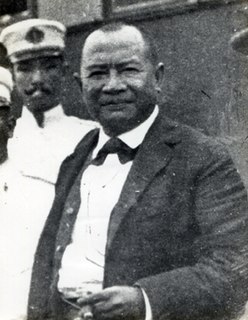 W
WBaldomero Aguinaldo y Baloy was a leader of the Philippine Revolution. He was the first cousin of Emilio Aguinaldo, the first president of the Philippines, as well as the grandfather of Cesar Virata, a former prime minister in the 1980s.
 W
WMariano Álvarez was a Filipino revolutionary and statesman.
 W
WDeodato Arellano was a propagandist and first president of the Katipunan. He was born to Juan de la Cruz and Mamerta de la Cruz on July 26, 1844 in Bulacan. The family changed their name to Arellano in compliance with the Claveria decree of 1849. Arellano studied bookkeeping at the Ateneo Municipal de Manila. He also worked as an assistant clerk at the arsenal of the military's artillery corps. He married Marcelo H. del Pilar’s sister, Hilaria del Pillar, on April 22, 1877, after his first wife, Paula Rivera, died.
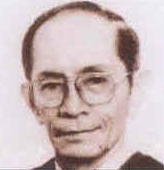 W
WAbdulwahid A. Bidin is a Filipino lawyer who was an Associate Justice of the Supreme Court of the Philippines. Appointed by President Corazon Aquino in 1987, he was the first Filipino Muslim named to the country's High Bench.
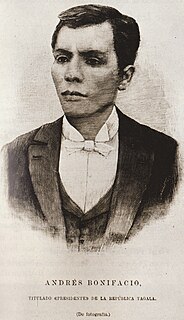 W
WAndrés Bonifacio y de Castro was a Filipino revolutionary leader and the president of the Tagalog Republic. He is often called "The Father of the Philippine Revolution". He was one of the founders and later Supremo of the Kataas-taasang, Kagalang-galangang Katipunan ng mga Anak ng Bayan or more commonly known as the "Katipunan", a movement which sought the independence of the Philippines from Spanish colonial rule and started the Philippine Revolution. He was also one of the Filipino historical figures to be recommended as a national hero of the Philippines.
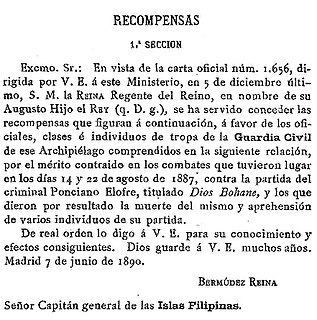 W
WPonciano Elofre, later called Dios Buhawi, was a cabeza (head) of a barangay in Zamboanguita in Negros Oriental, Philippines, and the leader of a politico-religious revolt in Negros in the late 19th century against the Spaniards.
 W
WFrancisco Dagohoy, was a Filipino revolutionary who holds the distinction of having initiated the longest revolt in Philippine history, the Dagohoy Rebellion. This rebellion against the Spanish colonial government took place on the island of Bohol from 1744 to 1828, roughly 85 years. Francisco Dagohoy started the revolt at the age of 20. He probably died before 1829 due to either old age or sickness.
 W
WPío del Pilar was a revolutionary general of the Philippines. To safeguard his family and prevent them from harassment, he changed his surname to del Pilar. He was born in Barrio Culi-culi, San Pedro de Macati on 11 July 1860.
 W
WLadislao Diwa y Nocon was a Filipino patriot who was among the founders of the Katipunan that initiated the Philippine Revolution against Spain in 1896.
 W
WSalvador Estrella was a Filipino general who fought in the Philippine Revolution and the Philippine–American War. For his courage in battle, he earned the moniker "red blooded."
 W
WThe Fifteen Martyrs of Bicol were Filipino patriots in Bicol, Philippines who were executed by firing squad on January 4, 1897, for cooperating with the Katipunan during the Philippine Revolution against Spain.
 W
WIsnilon Totoni Hapilon, also known by the nom de guerre Abu Abdullah al-Filipini, was a Moro Islamist militant affiliated with ISIS.
 W
WDionisio Magbuelas, Dionisio Seguela or Dionisio Papa y Barlucia, more widely known as Papa Isio, was the leader of a group of babaylanes who were, as conjectured by Modesto P. Sa-onoy, recruited from the remnants of the followers of Dios Buhawi upon the dissolution of his group under the poor leadership of Camartin de la Cruz during the years prior to the onset of the Philippine Revolution.
 W
WEmilio Jacinto was a Filipino General during the Philippine Revolution. He was one of the highest-ranking officers in the Philippine Revolution and was one of the highest-ranking officers of the revolutionary society Kataas-taasan, Kagalang-galang na Katipunan ng mga Anak ng Bayan, or simply and more popularly called Katipunan, being a member of its Supreme Council. He was elected Secretary of State for the Haring Bayang Katagalugan, a revolutionary government established during the outbreak of hostilities. He is popularly known in Philippine history textbooks as the Brains of the Katipunan while some contend he should be rightfully recognized as the "Brains of the Revolution". Jacinto was present in the so-called Cry of Pugad Lawin with Andrés Bonifacio, the Supremo of the Katipunan, and others of its members which signaled the start of the Revolution against the Spanish colonial government in the islands.
 W
WKhadaffy Abubakar Janjalani was the nominal leader of the Moro militant group known as Abu Sayyaf and the leader of one of its factions.
 W
WAgueda Kahabagan y Iniquinto was a Philippine general in the Philippine Republican Army and a member of the Katipunan.
 W
WDatu Hadji Kamlon, also known as Maas Kamlon, was a Tausug who fought during the Second World War, and afterwards, staged his own uprising against the Philippine government under Presidents Elpidio Quirino and Ramon Magsaysay. He is regarded as a folk hero among the Tausugs.
 W
WThe Kataastaasan, Kagalanggalang Katipunan ng mga Anak ng Bayan, also known as Katipunan or KKK, was a Philippine revolutionary society founded by anti-Spanish colonialism Filipinos in Manila in 1892; its primary goal was to gain independence from Spain through a revolution.
 W
WMuhammad Dipatuan Kudarat (1581–1671) was the 7th Sultan of Maguindanao from 1619 to 1671. During his reign, he successfully fought off Spanish invasions and hindered the spread of Roman Catholicism in the island of Mindanao much like the other Muslim rulers of the southern Philippine archipelago. He was a direct descendant of Shariff Kabungsuwan, a Malay-Arab Johor noble who brought Islam to Mindanao between the 13th and 14th century. The Soccsksargen province of Sultan Kudarat is named after him, together with the Municipality of Sultan Kudarat, Maguindanao, where his descendants of Datus and rulers are still the current political leaders.
 W
WJusto Lukban was a Filipino physician and politician. Lukban was elected to the Philippine Assembly and was mayor of the capital Manila from 1917 until 1920.
 W
WVicente Lukbán y Rilles or Vicente Lucbán Rilles was a Philippine General in the Philippine Republican Army.
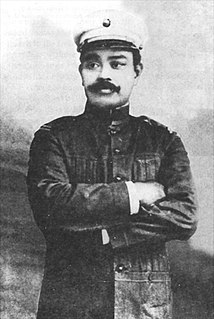 W
WAntonio Narciso Luna de San Pedro y Novicio Ancheta was a Filipino army general who fought in the Philippine–American War.
 W
WApolinario Mabini y Maranan was a Filipino revolutionary leader, educator, lawyer, and statesman who served first as a legal and constitutional adviser to the Revolutionary Government, and then as the first Prime Minister of the Philippines upon the establishment of the First Philippine Republic. He is regarded as the "utak ng himagsikan" or "brain of the revolution".
 W
WFrancisco Macabulos y Soliman was a Filipino patriot and revolutionary general who led the Katipunan revolutionary forces during the Philippine Revolution against Spain in 1896.
 W
WDiosdado Pangan Macapagal Sr. was the ninth President of the Philippines, serving from 1961 to 1965, and the sixth Vice-President, serving from 1957 to 1961. He also served as a member of the House of Representatives, and headed the Constitutional Convention of 1970. He was the father of Gloria Macapagal Arroyo, who followed his path as President of the Philippines from 2001 to 2010.
 W
WTeresa Magbanua y Ferraris, better known as Teresa Magbanua and dubbed as the "Visayan Joan of Arc", was a Filipino schoolteacher and military leader. Born in Pototan, Iloilo, Philippines, she retired from education and became a housewife shortly after her marriage to Alejandro Balderas, a wealthy landowner from Sara, Iloilo. When the 1896 Philippine Revolution against Spain broke out, she became one of only a few women to join the Panay-based Visayan arm of the Katipunan, the initially secret revolutionary society headed by Andrés Bonifacio.
 W
WRamon del Fierro Magsaysay Sr. was a Filipino statesman who served as the seventh President of the Philippines, from December 30, 1953 until his death in an aircraft disaster. An automobile mechanic by profession, Magsaysay was appointed military governor of Zambales after his outstanding service as a guerilla leader during the Pacific War. He then served two terms as Liberal Party congressman for Zambales before being appointed Secretary of National Defense by President Elpidio Quirino. He was elected president under the banner of the Nacionalista Party.
Miguel Malvar y Carpio was a Filipino general who served during the Philippine Revolution and, subsequently, during the Philippine–American War. He assumed command of the Philippine revolutionary forces during the latter, following the capture of Emilio Aguinaldo by the Americans in 1901. According to some historians, he could have been listed as one of the presidents of the Philippines but is currently not recognized as such by the Philippine government.
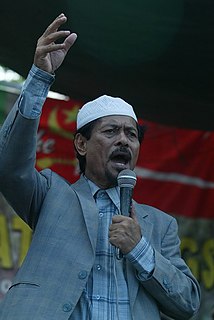 W
WNur Misuari is a Moro revolutionary and politician, founder and leader of the Moro National Liberation Front.
 W
WBlas Fajardo Ople was a Filipino journalist and politician who held several high-ranking positions in the executive and legislative branches of the Philippine government, including as Senate President from 1999 to 2000, and as Secretary of Foreign Affairs from 2002 until his death. Perceived as a leftist-nationalist at the onset of his career in public service, Ople was, in his final years, a vocal supporter for allowing a limited United States military presence in the Philippines, and for American initiatives in the War on Terror including the 2003 U.S. invasion of Iraq.
 W
WDatu Salipada Khalid Pendatun was a Filipino lawyer, military officer, and a statesman, being the first Filipino Muslim in history to hold these offices. He died on January 27, 1985 in Quezon City.
 W
WGregorio Hilario del Pilar y Sempio was a Filipino general of the Philippine Revolutionary Army during the Philippine–American War.
 W
WApolinario de la Cruz, better known as Hermano Pule, was a Filipino religious leader who founded and led the Cofradía de San José. The cofradía was established in 1832 in response to the racially discriminatory practices of the Catholic Church in the Philippines. During the Spanish colonial period, Catholic religious orders refused to admit native Filipinos as members. In retaliation, Pule established his own religious order which was exclusive for native Filipinos. During its peak, the cofradía had 4,500 to 5,000 members from the provinces of Tayabas, Batangas, and Laguna. Fearing an armed rebellion, the Spanish colonial government sent military forces to suppress the cofradía, an attack that was resisted by Hermano Pule and his followers on October 23, 1841. However, more troops were sent and the cofradía was finally quelled by the colonial military forces on November 1, 1841. Pule was then captured, tried, and executed.
 W
WElpidío Rivera Quiríno was a Filipino politician of ethnic Ilocano descent who served as the sixth President of the Philippines from 1948 to 1953.
 W
WArtemio Ricarte y García was a Filipino general during the Philippine Revolution and the Philippine–American War. He is regarded as the Father of the Philippine Army, and the first Chief of Staff of the Armed Forces of the Philippines though the present Philippine Army grew out of the forces that fought in opposition to, and defeated the Philippine Revolutionary Army led by General Ricarte. Ricarte is also notable for never having taken an oath of allegiance to the United States government, which occupied the Philippines from 1898 to 1946.
 W
WJainal Antel Sali Jr. was the leader of Abu Sayyaf, an Islamist terrorist organization affiliated with Al Qaeda.
 W
WJovito "Jovy" Reyes Salonga was a Filipino statesman and lawyer, as well as a leading opposition leader during the regime of Ferdinand Marcos from the declaration of martial law in 1972 until the People Power Revolution in 1986, which removed Marcos from power. Salonga was the 14th President of the Senate of the Philippines, serving from 1987 to 1992.
 W
WAlejo Santos Santos was a Filipino soldier and World War II hero who parlayed his fame into a political career. His prestige was somewhat marred in later life when he agreed to run as the only major candidate opposing Ferdinand Marcos in the widely fraudulent 1981 Philippine presidential election.
 W
WDatu Sikatuna as the Datu of the island of Bohol in the Philippines. His real name was "Katuna" but "Si" was added to his name as this is a nominative marker for a Filipino. He made a blood compact (sanduguan) and alliance with the Spanish explorer Miguel López de Legazpi on March 16, 1565 near the modern town of Loay.
 W
WDiego Silang ; December 16, 1730 – May 28, 1763) was a Filipino revolutionary leader who allied with British forces to overthrow Spanish rule in the northern Philippines and establish an independent Ilocano state. His revolt was fueled by grievances stemming from Spanish taxation and abuses, and by his belief in self-government, that the administration and leadership of the Roman Catholic Church and government in the Ilocos be invested in trained Ilocano officials. He met an Itneg woman with the name of Gabriela Cariño.
 W
WMaría Josefa Gabriela Cariño de Silang was a Filipina revolutionary leader best known as the first female leader of an Ilocano movement for independence from Spain. She took over the reins of her husband Diego Silang's revolutionary movement after his assassination in 1763, leading the Ilocano rebel movement for four months before she was captured and executed by the colonial government of the Spanish East Indies.
 W
WTamblot was a babaylan or native priest from Bohol, Philippines, who led the Tamblot Uprising in 1621 to 1622 during the Spanish era. He opposed the new religion spread by the Spaniards and fought against the subsequent conversion of the Boholanos to the Catholic faith. According to Legend, he challenged the Spanish priest, and when he won, he earned the trust of the people. He exhorted them free themselves from Spanish oppression, leading 2,000 followers in what was dubbed as the "Tamblot Uprising" or "Tamblot Revolt".
 W
WLuis Mangalus Taruc was a Filipino political figure and rebel during the agrarian unrest of the 1930s until the end of the Cold War. He was the leader of the Hukbalahap group between 1942 and 1950. His involvement with the movement came after his initiation to the problems of agrarian Filipinos when he was a student in the early 1930s. During World War II, Taruc led the Hukbalahap in guerrilla operations against the Japanese occupants of the Philippines.
 W
WThe Thirteen Martyrs of Bagumbayan were Filipino patriots in the Philippines who were executed by musketry on January 11, 1897, for cooperating with the Katipunan during the Philippine Revolution against Spain.
 W
WThe Thirteen Martyrs of Cavite were Filipino patriots in Cavite, Philippines who were executed by musketry on September 12, 1896, for cooperating with the Katipunan during the Philippine Revolution against Spain. The de facto capital city of Trece Martires in Cavite is named after them.
 W
WManuel Tinio y Bundoc was the youngest General of the Philippine Revolutionary Army, and was elected Governor of the Province of Nueva Ecija, Republic of the Philippines in 1907. He is one of those considered to be the three "Fathers of the Cry of Nueva Ecija", along with Pantaleon Valmonte and Mariano Llanera.
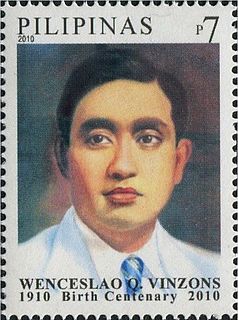 W
WWenceslao “Bintao” Quinito Vinzons was a Filipino politician and a leader of the armed resistance against the Japanese occupying forces during World War II. He was the youngest member of the 1935 Constitutional Convention. Among the first Filipinos to organize the guerrilla resistance after the Japanese invasion of the Philippines in 1941, he was executed by the Japanese Army. For leading demonstrations as a student leader, he was dubbed the "Father of Student Activism in the Philippines".